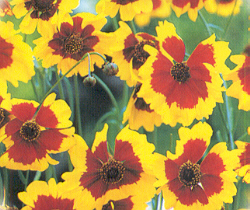






Perennial, Coreopsis Grandiflora
Coreopsis flowers are members of the sunflower family. They look a lot like a daisy. Sometimes called "Tickseed" or "Calliopsis", this attractive plant has yellow, gold, red, maroon, or a combination of these colors ,on sturdy stalks that grow from 1 1/2' to 4' tall. While most Coreopsis are perennials, there are a few annual varieties. It is native to prairies and dry plains.
Coreopsis gets it's name from the Greek word for "bug". It was given this name because its dried, flat fruit resembles a bug.
The Coreopsis flower attracts butterflies. Songbirds like the pods, filled with seed. Coreopsis makes excellent cut flowers, too. The strong stems do not require staking.
Plant Height: 1 1/2' - 2 1/2 ' depending upon variety
Plant Propagation:
Coreopsis are grown from seed. They can be directly seeded into your flower garden in early spring.
Sow Coreopsis seeds early in the season, covering lightly with coarse or sandy soil. Keep the soil moist until they germinate, about one of two weeks.
Final spacing for the plants is about 12" apart. Plants will bloom approximately 60 days after planting.
Days to Germination: 7 - 30, depending upon variety
Note: For varieties with a long germination period, we recommend a heated germination mat.
Popular Varieties: Lance Leaved, Sunray
How to Grow Coreopsis Plants:
Growing Coreopsis is easy. Once established, they will thrive for years.
Coreopsis plants prefers a warm climate and full to partial sun. Being native to prairies and dry plains, it prefers a dry environment, but will tolerate occasional wet weather.
Mix in plenty of compost prior to the first planting. During dry periods, it will survive with little water. But, it's absolutely okay to pamper it with an occasional drink of water. Coreopsis does not need a rich soil. But, it will benefit from a dose of fertilizer once or twice a season.
Flowers Blooms: spring, summer, or fall, depending upon variety, See seed packets.
Insect and Disease:
If insect or disease problems occur, treat early with organic or chemical insect repellents and fungicide.
Copyright © www.100flowers.win Botanic Garden All Rights Reserved